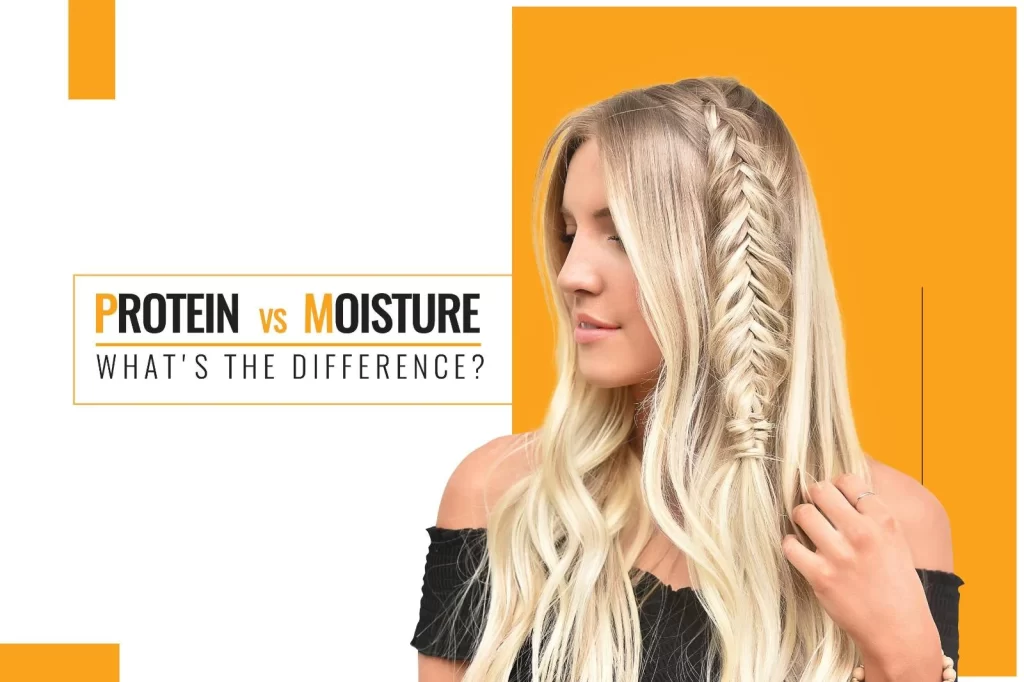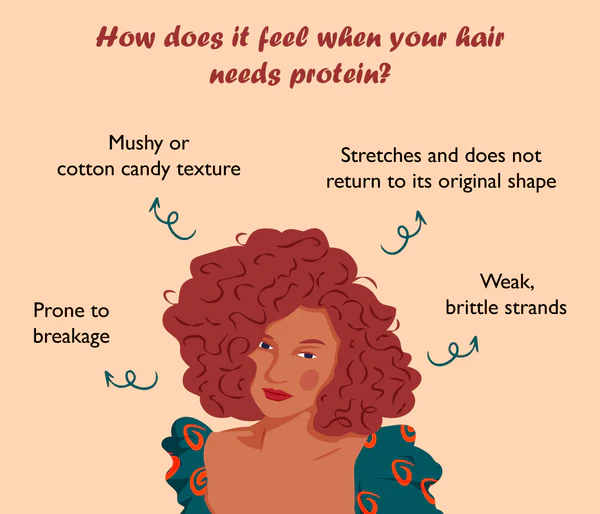In hair care, the quest for luscious locks often feels like a journey through a maze of products, treatments, and advice. Among the myriad options, two key players emerge: protein and moisture in hair. These elements play pivotal roles in maintaining the health and vitality of your hair, but determining which your hair needs can sometimes feel like deciphering a cryptic code. But fear not, for in this exploration, we embark on a journey to unravel the signs that indicate your hair’s specific needs, and equip you with the knowledge to make informed decisions for the big question: protein vs moisture – what do I need?
I. Protein vs Moisture: What's The Difference?
Before you begin any type of hair care, you must grasp the distinction between the two. The distinction between protein and moisture begins at the atomic level.

Each strand of hair is held together by what are known as Disulfide bonds. Proteins strengthen these bonds, making hair stronger and less prone to breakage. Moisture, on the other hand, adds to the overall appearance and feel of your hair. Protein bonds are what hold the hair shaft together and make it strong. Your hair will break if you do not use it. Moisture is what keeps the hair smooth and hydrated.
II. How To Tell If Your Hair Needs Protein Or Moisture?
Knowing whether your hair needs protein or moisture is essential for maintaining its health and addressing any issues effectively. Here’s a guide to help you determine whether your hair needs protein or moisture:
1. Signs Your Hair Needs Protein:
If your hair has a protein deficiency, you’ll notice the following:

- Excessive Breakage: If you notice your hair breaking easily, especially when it’s wet or when combing, it could indicate a lack of protein.
- Lack of Elasticity: If your hair feels limp and doesn’t spring back when stretched, it may need protein to regain its elasticity.
- Soft, Mushy Texture: Hair that feels overly soft and mushy, particularly when wet, may indicate an imbalance of protein.
2. Signs Your Hair Needs Moisture:
If your hair is dehydrated, you’ll notice the following:

- Dryness and Brittle Texture: If your hair feels dry, brittle, and lacks flexibility, it likely needs moisture. Dry hair is often dull in appearance and prone to breakage.
- Frizz and Flyaways: Lack of moisture can lead to frizz and flyaways, especially in humid conditions.
- Tangles and Knots: If your hair is prone to tangling and knots, it may be lacking moisture, causing the strands to become rough and catch on each other.
- Scalp Dryness or Irritation: Dry hair often goes hand in hand with a dry scalp, leading to itching, flaking, and irritation.
→ By understanding the signs of protein or moisture imbalance, you can tailor your hair care routine to keep your locks healthy, strong, and vibrant.
III. How To Treating Moisture Loss and Protein Imbalance in Your Hair?
Now we’re going to delve deep into the world of hair care and uncover the secrets to treating moisture loss and protein imbalance effectively. Whether you’re dealing with chemically treated hair, heat damage, or simply looking to improve the overall health of your locks, understanding these fundamental principles is key to achieving your hair goals.
1. Treating Moisture Loss In Your Hair
Although most damaged hair can only be treated through products made using proteins, some damage does actually require moisture. Moisturizing treatments usually have ingredients like fatty acids, oils, and butter, which penetrate into the scalp and restore dry hair with necessary hydration. To treat moisture loss in your hair, you’ll need to get your hair care regimen down. This includes things like:

- Pre-poo Treatments: Apply a moisturizing treatment to your hair before you wash it. This helps make it easier to detangle, as well as boost the effectiveness of your conditioner or deep conditioner when washing, to lock in moisture. Some pre-poo treatments include oils (coconut oil, avocado oil, almond oil), aloe vera, coconut milk, or shea butter.
- Use the LOC method (Liquid, Cream, Oil): Apply moisturizing products from lightest to heaviest. This allows the liquid product to sink into the hair, and the oil to lock it in.
- Apply hair products while your hair is warm and wet: At this stage, your hair cuticles are lifted, allowing more moisture in. Use hair products with humectant ingredients like glycerin, honey, and agave.
- Use deep conditioners regularly: These products penetrate the hair shaft more deeply than regular conditioners, giving your hair much-needed added moisture. Bonus points if you leave it in for 15-20 minutes with a shower cap or heat cap on!
2. Treating Protein Imbalances In Your Hair
Protein treatments are usually produced from plants such as wheat, soy, rice, or silk, and contain hydrolyzing proteins, which fill in damage on the hair shaft, making it stronger and healthier.

- Watch your diet: Although products have been found to restore protein in hair, the truth is that the main cause of protein deficiencies is your food.
- Try dietary supplements: like biotin, and be sure to track your protein intake, adding protein-rich foods like beef, chicken, salmon, eggs, lentils, beans, and Greek yogurt.
→ Pro tip: It’s important to also balance your moisture and protein treatments according to your hair’s porosity. Low-porosity hair usually needs more moisture, and high-porosity hair usually needs more protein.
IV. Protein vs Moisture: What Do I Need?

Yes! The bottom line is hair needs both moisture and protein for good health and strength. The best hair has a balance of both protein and moisture, for bouncy, shiny hair, and strong hair strands. Hair lacking proteins loses elasticity, which increases the risk of breakage and reduces moisture retention while without moisture, even the strongest hair will be dull and lifeless.
V. Protein vs Moisture - What Do I Need: Final Thought
In conclusion, achieving optimal hair health requires a balanced approach that considers both protein and moisture needs. Understanding your hair’s unique characteristics and responding accordingly is key. While protein strengthens the hair shaft, moisture ensures flexibility and elasticity, preventing breakage and promoting overall health. Over-reliance on either can lead to imbalances and potential damage. Regular assessment of your hair’s condition and adjusting your hair care routine accordingly can help unlock its full potential. Remember, a holistic approach that incorporates both protein and moisture is essential for vibrant, resilient locks.


 BEST SELLING PRODUCTS
BEST SELLING PRODUCTS Wig Hair
Wig Hair WHOLESALE
WHOLESALE Contact us
Contact us Sale Events
Sale Events